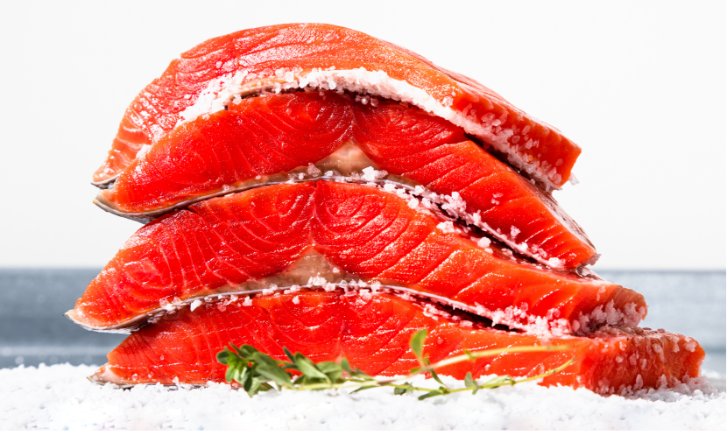What is Copper River Salmon and Why is It So Expensive?
Copper River salmon is a type of Alaskan salmon that is famous for its taste and quality.
Due to its limited availability, both high-end restaurants and home cooks compete each year to get their share of this five-star salmon. If you have never tried Copper River salmon, you might wonder why this type of salmon is more expensive than other types of salmon.
There is plenty of fish in the sea--especially when it comes to salmon. There are farm-raised, wild, Atlantic, Norwegian, and Alaskan. Choosing the right one for you can be overwhelming since they all vary in the categories of taste, quality, nutritional value, sustainability, and availability. Copper River salmon almost receives a perfect score, ranking #1 in 4 of the 5 categories. Availability is its only struggle. They are a wild and seasonal fish caught in the frigid waters of Alaska that seafood lovers, chefs, and foodies anxiously wait for every summer.

The Wagyu of Seafood
Copper River salmon, specifically the Copper River King salmon, has gotten the title of “The Wagyu of Seafood” and “The King of King salmons’ because of its succulent and buttery texture from their natural yet wild genetics.
These salmon carry the highest amount of omega-3 fatty acids compared to the others. This comes from their biological need to store extra fat for energy to return home to their spawning grounds up the Copper River. The river is 300 miles long; lined with massive glaciers and an elevation increase of 3,600 feet, causing it to be the most difficult salmon migratory terrain in the world! Because of this frigid and taxing journey, the salmon must store extra fat and omega-3s in their bodies, giving it a buttery texture and robust flavor, attracting the attention of Michelin-starred chefs, restaurants, and popular fish markets, every year. The best part is, cooking Copper River salmon is pretty easy and you can enjoy it at home with your family.

The First Wild Salmon Run of the Year
Every year, the salmon that have reached maturity return home to breed. These fish are highly sensitive to water temperature, but because of the extra fat the Copper River salmon carry, they’re able to travel colder waters sooner than the rest. This makes the Copper River salmon season the very first wild salmon run of the year. You may be wondering how they navigate and know when to return home. Salmon have an incredible sense of smell, and they use the characteristics of their natal waters to navigate from the Pacific Ocean back to the exact rivers they came from. After a long winter, like spring vegetables and seasonal fruit, we always look forward to the start of the Copper River salmon season.
Limited Availability
Unlike farmed salmon where buyers have the ability to purchase year-round from their fish pens, wild salmon cannot be manufactured. Their runs are seasonal and the size of the run can vary drastically each year. Beginning mid-May, the sockeyes and kings begin to arrive. Kings continue to fill the waters through mid-June, while the sockeyes stick around until early August. The Coho, or Silver salmon make their appearance in July and continue their run until September. Once the season ends for wild salmon, that's it. As the source of the most delectable salmon, Copper River hosts the first wild salmon run of the year in the US. Consumers need to plan and purchase when it is available if they want to have wild Alaskan salmon during the fall and winter months.
Sustainability
Fun fact: Salmon is the most popular seafood and the most cooked seafood in homes. So, with that being said, wild salmon and farmed salmon both have their places at the table. However, unlike farmed salmon that consumes pellets that are frequently made up of antibiotics and other additives, Copper River salmon breed and feed in their natural environments. In the wild, salmon feed on smaller fish, krill, shrimp, and other small amphipods, which is where they get their color and nutritional content.
Copper River has high standards when it comes to sustainable fishing efforts. There are many heavily enforced rules the fishermen must follow to ensure the health of future Alaskan salmon runs. To give you a few examples: The fishing nets are not allowed to surpass 900 feet in length. The net must always be free flowing, never tied down in a fixed position, making it easier for the salmon to swim around. The netting is also required to be colored as opposed to using a clear meshing. This gives the fish yet another chance to see and avoid the nets. To avoid overfishing, there are only certain times and certain areas that are open for fishing on any given day. We are grateful to have our local Fish and Game constantly patrolling the areas, helping to keep our oceans and people protected.
The Gold Standard
Wild Alaskan salmon is heavily regulated by the State of Alaska. It is written in our state constitution that we must provide sustainable fisheries, which is why Alaska is known as the gold standard for sustainable fishing practices. Owned and operated by local fishermen, Alaskan Salmon Co. commits to sustainability and empowerment of local communities. By leveraging the power of the internet, we are disrupting the traditional supply chain and connecting the consumers directly to the fishermen. Our meticulous fishing and handling process supports a more sustainable future for the ocean and local communities.
Processed and packaged 100% in the USA, our Copper River salmon reflects our commitment to support transparency and open-door policy to our customers and local communities. By removing the middlemen, we bring you the unparalleled quality and taste of Copper River salmon delivered to your home.


